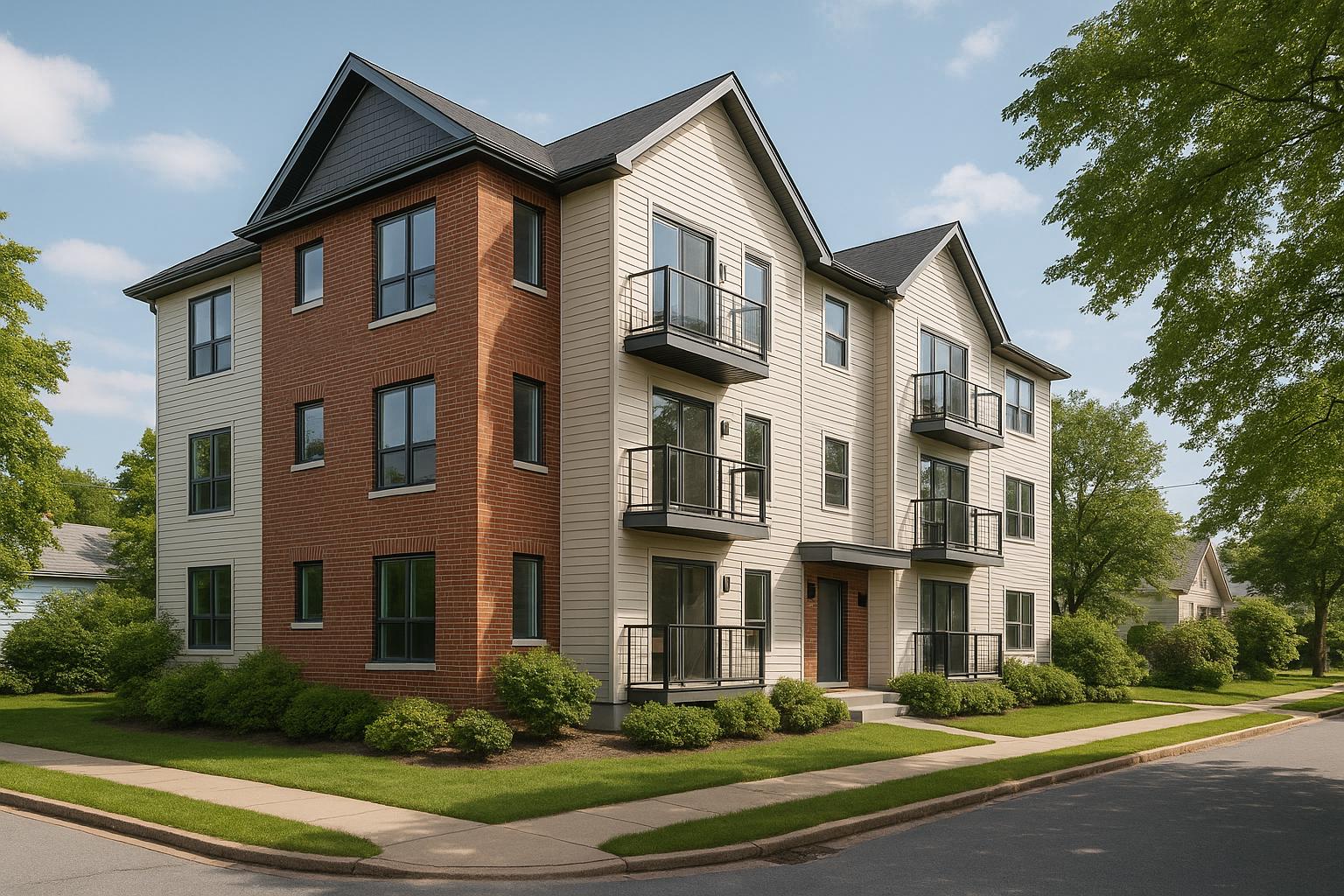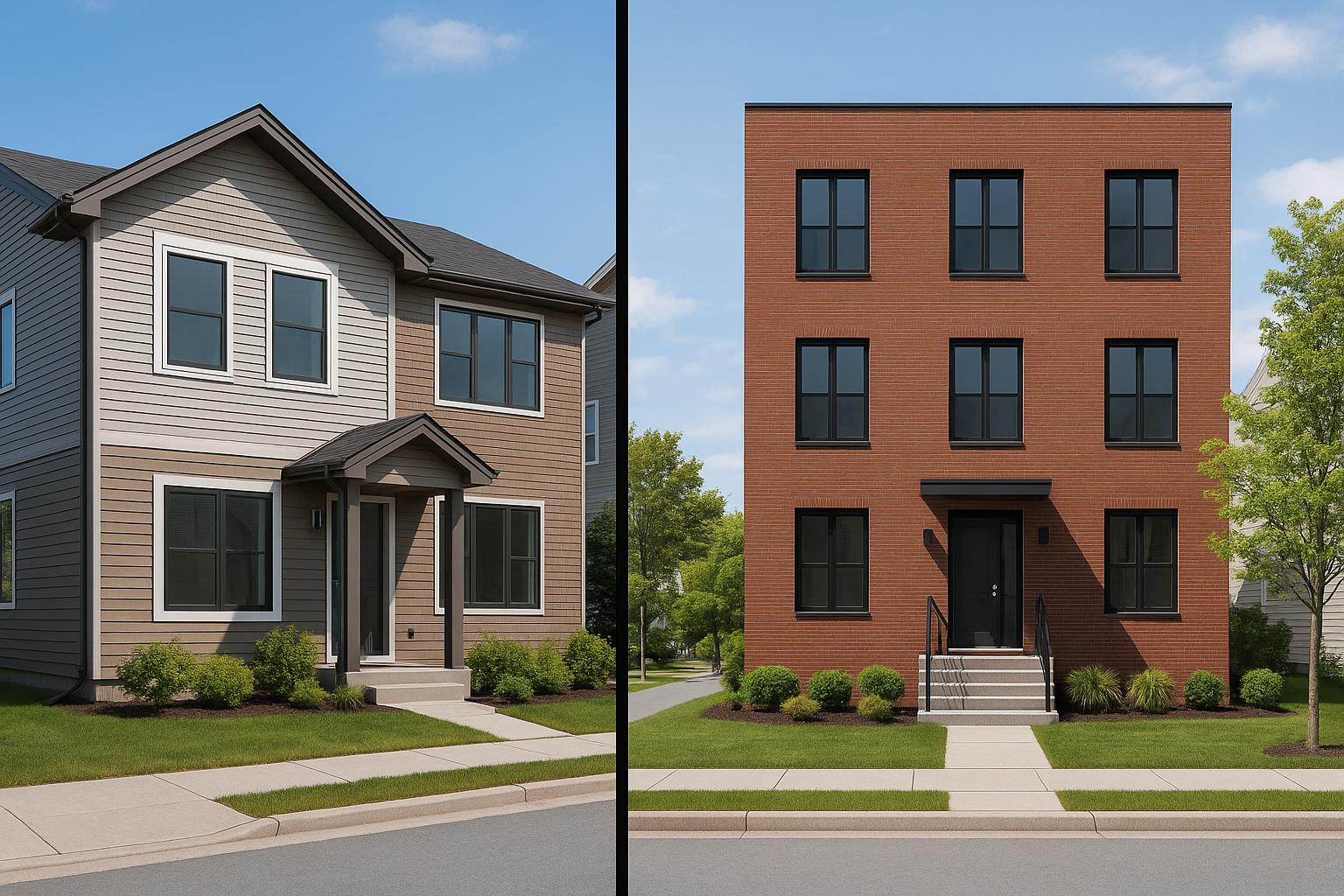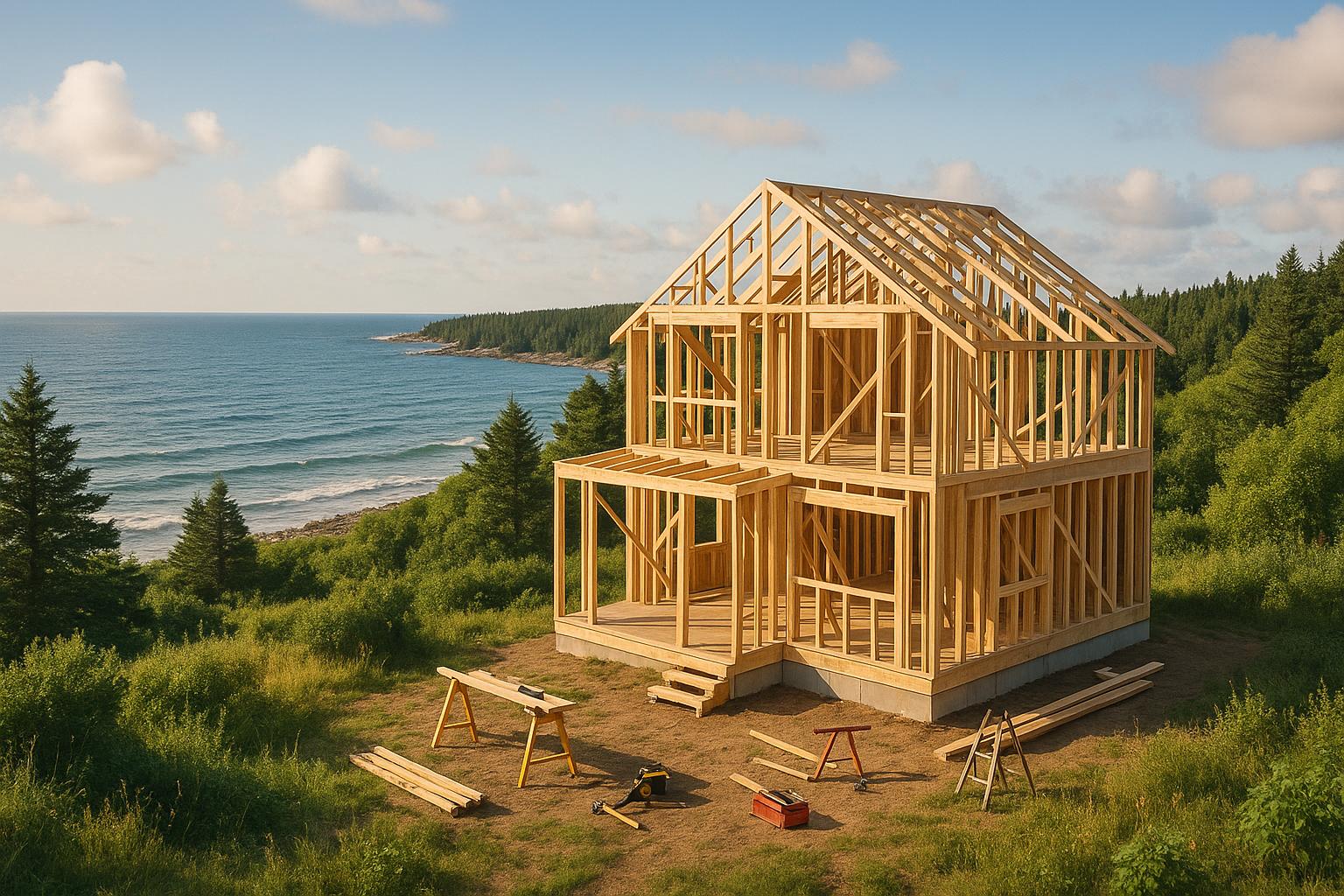ER-3 zoning in Nova Scotia allows property owners to build 4 to 8 rental units on lots ranging from 375 to over 600 m², offering a chance to maximize rental income. Here’s what you need to know:
- Lot Size Determines Units: Smaller lots support up to 4 units, mid-sized lots allow 5–7 units, and larger lots can accommodate up to 8 units.
- Zoning Rules Impact Design: Setback, height, and lot coverage limits shape building layouts.
- Construction Costs: Building costs range from $160,000 to $200,000 per unit, with potential annual returns of 12–20%.
- Streamlined Process: Fixed-price contracts ensure predictable costs and timelines, with options like the Premium Rental Ready Package for immediate rental income.
Start by confirming your lot’s zoning and size, then choose a design that balances unit count and tenant needs while adhering to zoning regulations.
How to Quickly Look Up Zoning in Halifax, Nova Scotia
How Lot Size Determines Your Maximum Unit Count
The size of your lot plays a crucial role in determining the number of units allowed under ER‑3 zoning. This connection is essential for property planning, helping you make informed decisions about your investment and avoid costly design missteps. Let’s break down how lot size and zoning regulations work together to shape your development possibilities.
Lot Size Ranges and Unit Limits
In ER‑3 zoning, the number of units you can build is tied to a tiered system based on lot size. Here’s a general idea of what to expect:
- Smaller lots typically allow up to 4 units.
- Larger lots can support as many as 8 units.
- Mid-sized lots usually fall in the range of 5 to 7 units, depending on how the building is configured and local zoning specifics.
Keep in mind, these ranges aren’t set in stone. Local zoning guidelines and overlays can influence these numbers, so it’s always a good idea to check with your local planning department before finalizing your plans.
Zoning Rules That Limit Development
Lot size isn’t the only factor affecting your development. Zoning rules can impose additional limits, even if your lot theoretically supports a certain number of units. Some common restrictions include:
- Setback requirements: These dictate how far buildings must be from property lines, reducing the buildable area.
- Lot coverage limits: These cap the percentage of the lot that can be developed.
- Height restrictions: These set maximum building heights and limit the number of storeys.
- Parking provisions: Rules around parking can impact building layout and space allocation.
- Fire safety standards: Larger multi-unit buildings often require additional design features to meet fire safety regulations.
To reach the maximum unit count while staying compliant, a well-thought-out design is essential. Always consult with local planning authorities to ensure your plans align with zoning requirements and avoid unforeseen obstacles.
Steps to Maximize Units on Your ER-3 Lot
Maximizing the number of units on your ER-3 lot requires careful planning and a clear understanding of zoning rules. By following these steps, you can make informed decisions, avoid unnecessary setbacks, and ensure your project reaches its full potential.
Step 1: Confirm Your Zoning and Lot Size
Before diving into development plans, it's essential to verify your zoning and lot dimensions. This step lays the groundwork for the entire process and helps you sidestep unexpected complications.
- Check your zoning classification: Use municipal zoning maps to confirm how your property is designated. For properties in Nova Scotia, resources like official zoning maps provide accurate classifications. These are the same maps used by organizations like MPAC to define neighbourhood characteristics[4].
- Verify your lot size with legal documents: Accurate measurements are crucial. Refer to trusted sources such as the Parcel Register, Land Titles Office documents, or Land Transfer Tax affidavits[4]. For precise dimensions, consider hiring a licensed Nova Scotia land surveyor. Their measurements meet permitting requirements and can save you from costly design revisions later[2][3].
Once you’ve confirmed these details, you can move forward with selecting a building layout that maximizes the number of units.
Step 2: Choose Your Building Configuration
With your zoning and lot size confirmed, the next step is to determine the best building design to maximize unit potential while meeting zoning regulations.
- For smaller lots, a compact multi-storey building - such as a stacked design - can provide the required four units while leaving room for parking and outdoor spaces.
- For mid-sized lots, a townhouse-style layout might be ideal, offering tenants private entrances and outdoor areas.
- For larger lots, you could consider a small apartment-style building, which allows for a higher unit count while adhering to zoning rules.
The goal is to find a configuration that not only meets zoning requirements but also maximizes rental income and tenant satisfaction. Don’t forget to factor in setback, parking, and outdoor space requirements during this stage.
Step 3: Handle Special Requirements
Certain restrictions or conditions might apply to your ER-3 lot, so it’s important to address these early in the process.
- Heritage or planning overlays: Some areas have additional rules governing building height, materials, or architectural details. Confirm with local authorities if any such overlays apply to your property before finalizing your design.
- Environmental considerations: Wetland setbacks, steep slopes, or tree preservation requirements can limit your buildable area. Conducting a preliminary environmental assessment can help identify these constraints early, giving your design team time to adjust plans.
sbb-itb-16b8a48
Design Approaches for Maximum Rental Income
When working within the constraints of ER-3 lot regulations, smart design decisions become crucial for boosting rental income. For properties with 4 to 8 units, every square metre matters in creating spaces that are both functional and profitable.
Efficient Floor Plans and Building Layout
The foundation of higher rental income lies in crafting spaces that tenants find practical and appealing. In Nova Scotia, well-thought-out two-bedroom units typically rent for around $1,950–$2,100 per month.
- Smaller lots: Stacked four-unit buildings make the most of limited space, offering two units per floor while maintaining privacy.
- Mid-sized lots: Separate entrances for units improve tenant satisfaction and use space effectively.
- Larger lots: Eight-unit designs with centralized utilities help reduce per-unit costs, increasing overall profitability.
These layouts not only maximize income potential but also address key tenant needs like parking and storage.
Addressing Parking, Privacy, and Tenant Needs
Parking often plays a pivotal role in the success of a rental property. In many ER-3 zones, the requirement is 1.5 parking spaces per unit - meaning a four-unit building needs six spaces. Surface parking remains the most affordable option compared to underground alternatives.
Storage is another essential factor. Features like built-in closets, basement storage lockers, and dedicated laundry areas cater to everyday tenant needs, boosting satisfaction. Adding private outdoor spaces, such as patios or balconies, can justify premium rents without significantly increasing construction costs.
Advantages of Integrated Design-Build Construction
Beyond efficient layouts, an integrated design-build approach can significantly cut costs and streamline the construction process. Traditional methods involving separate contracts often drive up costs by 30% to 60% and extend project timelines from 8 months to over 18 months. In contrast, the integrated design-build model eliminates the need for coordinating multiple contractors, saving both time and money.
A fixed-price construction model adds another layer of financial predictability. For instance, Helio Urban Development offers a guaranteed cost of $160,000 per unit and imposes penalties of up to $1,000 per day for delays. This ensures projects remain on budget and rental income starts on schedule.
Money and Permits for ER-3 Projects
The ER-3 model thrives on a streamlined design-build approach, ensuring clear financial guidelines and a straightforward permit process. Understanding these aspects is crucial to hitting your rental income goals.
Construction Costs and Expected Returns
For 4-to-8-unit properties, construction costs typically fall between $160,000 and $200,000 per unit, depending on the specifications and energy efficiency features you choose. Keep in mind that these figures cover only building costs - they don’t include land purchase or development fees.
Here’s how the numbers break down: At $160,000 per unit, a two-bedroom unit can generate monthly rental income of $1,950–$2,100, translating to annual returns of 12–20%. For instance, a four-unit building with a total construction cost of $640,000 could bring in $7,800–$8,400 per month in rental income.
If you opt for the CMHC MLI Select program, the higher cost of $200,000 per unit comes with perks like 95% financing, only 5% down, and a generous 50-year amortization period.
For those looking to hit the ground running, the Premium Rental Ready Package is available for an additional $15,000 per unit, covering appliances and smart tech, so you can start earning rental income immediately.
Getting Permits and Approvals
ER-3 projects require two key permits: a Development Permit and a Construction Permit. The good news? Most ER-3 developments qualify as "as-of-right" projects, meaning they comply with existing zoning rules and enjoy a smoother approval process [5].
- Development Permit: Confirms your project aligns with zoning requirements. ER-3 zoning supports a range of housing types, including single-family homes, duplexes, semi-detached homes, three-unit dwellings, townhomes, backyard suites, and secondary suites [1][5]. Most 4-to-8-unit designs fit neatly within these guidelines.
- Site Plan Approval: Usually not required unless your project requests specific deviations from the Land Use By-law [5].
- Construction Permit: Needed for any construction exceeding $5,000. These permits must comply with the Nova Scotia Building and Plumbing Code [6].
- Subdivision Approval: Required only if the project involves dividing land [6].
Once permits are secured, a fixed-price contract ensures costs and timelines are locked in, giving you predictable cash flow and peace of mind.
Fixed-Price Contracts and Construction Guarantees
Fixed-price contracts take the guesswork out of construction by eliminating the risk of cost overruns and delays. Traditional construction methods often see costs balloon by 30–60%, with timelines for 8-month projects stretching to 18 months or more. Fixed-price agreements eliminate these headaches by locking in costs before work begins.
Helio Urban Development offers guaranteed construction at $160,000 per unit, with a contractual completion timeline of just 6 months. They even include penalties of up to $1,000 per day for delays, protecting rental income. For a four-unit building, this could mean safeguarding approximately $8,800 per month in rental earnings.
Their fixed-cost model also simplifies financing, with a clear draw schedule and a firm completion date. This helps you plan rental marketing and cash flow with confidence.
Quality assurance is a key part of the package, featuring:
- A triple verification system
- Five Professional Engineer inspections (including one selected by the owner)
- A two-year warranty
- Daily photo updates and real-time access through a project portal
This approach ensures not just financial stability but also a high-quality build, delivered on time.
Making ER-3 Zoning Work for You
ER-3 zoning opens the door to 4–8 unit rental developments, especially when paired with an integrated design-build approach. To make the most of this opportunity, it’s essential to move away from traditional, fragmented construction methods that often lead to delays and unexpected costs.
Key Considerations for Property Owners
Understand your lot’s potential: A 375 m² lot can accommodate 4 units, while a 600+ m² lot can support up to 8 units with efficient design. It’s not just about the number of units - how they’re configured plays a big role in maximizing rental income.
Streamline construction with integrated design-build: Traditional projects often involve juggling six or more separate professionals, which can lead to miscommunication, delays, and budget overruns. By choosing an integrated approach, you can avoid these common pitfalls and keep your project on track.
Fixed-price contracts protect your timeline and income: Delays in construction mean delays in rental income. Helio Urban Development offers fixed-price contracts with a guaranteed six-month timeline and penalty clauses to address delays, ensuring your rental revenue starts on time.
Bank-grade quality, guaranteed: Helio Urban Development uses a triple verification process that includes five engineer inspections - one of which is conducted by the owner. This, combined with a two-year warranty, ensures your building meets professional standards from the very beginning.
Your Next Steps
To move forward, start by confirming your lot’s zoning designation and measurements. Municipal records can sometimes be inaccurate, so double-checking these details is crucial to determine your property’s capacity under ER-3 regulations.
Once your lot’s details are verified, focus on design configurations that balance unit count with rental appeal. For example, two-bedroom units typically rent for $1,950–$2,100 per month, offering a 12–20% annual ROI when construction costs remain around $160,000 per unit.
For a professional assessment, connect with Helio Urban Development. As Nova Scotia’s only integrated design-build company focusing on 4+ unit rental properties, they bring extensive experience to the table. With 31 units currently under construction and 131 more in planning across municipalities within 90 minutes of Halifax, their proven approach minimizes the risks that derail most multi-unit projects.
If you want to hit the ground running, consider the Premium Rental Ready Package for an additional $15,000 per unit. This turnkey solution ensures your units are ready for tenants immediately, saving you the hassle of furnishing and letting you start collecting rent right away.
FAQs
How can I make sure my ER-3 project meets zoning rules and avoids costly mistakes?
To ensure your ER-3 development aligns with Halifax's zoning regulations and avoids design missteps, start by thoroughly examining the ER-3 zoning guidelines. These rules outline key factors like lot coverage limits (40–60%) and a maximum of eight units per lot, depending on the size and layout of the property. It's also essential to review the Nova Scotia Building Code to ensure your project meets all safety and design standards.
Connecting with local planning authorities early in the process is a smart move. They can confirm your project's compliance and guide you through securing the necessary permits. Collaborating with architects or planners who have experience with ER-3 zoning can make a big difference - they'll help you navigate specific requirements and avoid expensive changes down the line. Additionally, staying updated on zoning maps and regulatory changes will help keep your project on track and in line with Halifax's local rules.
What financial advantages does a fixed-price contract and integrated design-build approach offer for ER-3 zoning projects in Nova Scotia?
A fixed-price contract paired with an integrated design-build approach offers clear budget control and reduces the likelihood of surprise costs, as the contractor assumes financial accountability. This method also simplifies the construction process, cutting down on delays and speeding up project completion - helping you get the most out of your investment.
In contrast to traditional methods, which often involve juggling multiple contracts and dealing with fluctuating expenses, this streamlined approach makes communication and decision-making easier. The result? You save both time and money while ensuring your ER-3 project stays on schedule.
How can I maximize rental income while staying compliant with ER-3 zoning rules for lot size and building design?
To make the most of rental income under ER-3 zoning regulations in Nova Scotia, it’s essential to focus on designing buildings that work within the zoning rules. For lots sized between 375 and over 600 m², you can typically construct anywhere from 4 to 8 rental units. The exact number depends on factors like the lot’s dimensions, the building’s height (up to 4 storeys), and the overall layout. Maximizing lot coverage - usually 40–60% - while respecting setback and dimension requirements is a smart way to use your space efficiently.
Effective planning plays a major role in striking the right balance between fitting into the neighbourhood and maximizing rental potential. By carefully considering the design and following zoning by-laws, you not only ensure compliance but also position yourself to boost your return on investment (ROI). Seeking expert advice and planning thoroughly can help you achieve the best outcomes for your property.



